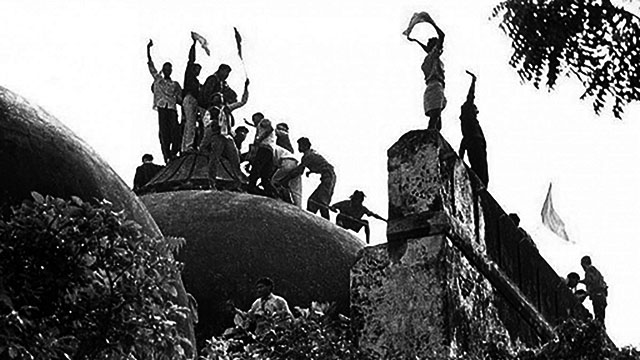Each year since 2019, December 6th—the anniversary of the 15th-century Babri Masjid demolition—mocks the conscience of those Indians who once believed that “secularism” promoted by the Nehruvian school of thought shall prevail and Prime Minister Narendra Modi can’t destroy what’s called the “idea of India”. It mocks those who considered the Babri Masjid demolition as a blot on India’s “secular” credentials and hoped for justice from the system.
The Supreme Court’s November 2019 Ayodhya verdict not only denied the Muslims their right to worship, as guaranteed by the Constitution, but it also, indirectly, endorsed the very crime of Babri Masjid demolition that the verdict itself condemned.
Though there were bleak chances of justice for the Muslim community in Modi-fied India, the way the land, where the demolished Babri Masjid once stood, was handed over to the Hindutva fanatics who tore it down with impunity in 1992, shocked many, who for years refused to wake up and smell fascism.
As the verdict came from the Supreme Court, therefore, no objections were raised, except a few revision petitions, which were eventually dismissed. The Muslims didn’t rally or rampage over the injustice done to the community. They accepted the setback with humility and most religious Muslims left the matter with the Almighty to settle.
It wasn’t the Muslim community’s weakness that it didn’t build up a movement against the Ayodhya injustice. The same community had hit the roads in thousands a month later, when the contentious Citizenship (Amendment) Act, 2019 (CAA 2019), was passed by the Parliament. The community had long given up hope over the mosque. They know, its demolition was the last straw pulled out from India’s so-called textbook “secularism”.
Now, revisiting the Babri Masjid demolition horror is an annual ritual on December 6th. The day is commemorated with a set of clichéd rhetoric. Either the ruling Bharatiya Janata Party (BJP) and other Hindutva fascist outfits under the aegis of the Rashtriya Swayamsevak Sangh (RSS), will express their jubilation, by celebrating the day, or the so-called “secular” camp will shed crocodile’s tears over the agony of the minority community.
Amid this, what’s lost is the futuristic approach. The Ram Mandir (temple of Hindu deity Lord Rama) is under construction at the site of the demolished Babri Masjid. Not only the Hindutva fascists under the RSS and the BJP are ebullient regarding the temple’s construction, but even its so-called opponents are busy hijacking the credit.
Self-styled Dalit leader Mayawati-led Bahujan Samaj Party (BSP), the Samajwadi Party of Akhilesh Yadav, Delhi Chief Minister Arvind Kejriwal’s Aam Aadmi Party (AAP), the Congress party’s Priyanka Gandhi Vadra and others have welcomed the construction of the Ram Mandir in Ayodhya.
Champions of secularism like Mayawati earlier announced that if she is elected to power in Uttar Pradesh, her government will hasten the Ram Mandir construction. Kejriwal asserted his “Hindu identity” by visiting the Ram Mandir. The others too joined the bandwagon to encash the benefits of majoritarian politics.
What does this tell us? It says that the Babri Masjid demolition is normalised in Indian politics and the Hindutva fascist ideology isn’t any more BJP’s monopoly. It’s a cause championed by almost all parliamentary parties. Then what’s the way forward than lamenting over the loss of the mosque and the façade of secularism?
It’s imperative for those who still swear allegiance to secularism to counter the Hindutva narrative by appealing to the broad masses of Dalits and backward caste Hindus and the tribal masses influenced by Hindutva that in the future Hindu Rashtra, ie, the theocratic dictatorship state of the upper-caste Hindus, they won’t be equal citizens. Apart from suffering caste atrocities, they will also suffer due to the economic oppression laden on them by the pro-corporate Hindutva fascist lobby.
The construction of the Ram Mandir has not saved the majority of lower-caste Hindus, Dalits and tribal masses from the skyrocketing prices of essential commodities, from a severe unemployment and farm crisis. Neither the Ram Mandir nor the Hindu Rashtra will ease their socio-economic woes but will aggravate them.
The way the RSS denied permission to the Dalit Matua community from West Bengal to join the foundation ceremony of the Ram Mandir in August 2020, shows how these communities shall fare in the Hindu Rashtra. The Hindu Rashtra will be the paradise of the upper-caste capitalists like Gautam Adani and Mukesh Ambani, it will be the fiefdom of feudal landlords and corporate honchos, not of the poor workers and farmers.
The Hindu Rashtra is a denial of rights to the majority of the people. The Babri Masjid demolition and the subsequent rampage of the neoliberal economy have proved that the poor have nothing to gain from the upper-caste Hindu community’s Islamophobic vitriol.
It’s for the sake of their survival and their right to equality and justice that the Dalits, the tribal masses and lower-caste Hindus must be mobilised in a struggle against the very economic order that demanded the Babri Masjid demolition. Without this, all talks about justice and fighting Hindutva fascism are mere empty rhetoric. But the question is, will any political force walk the tightrope?
Editorial desk of People's Review provides you the editorial view point and also shares the outlook of the collective wisdom that manages the publication. Send letters to the editor at: Write2us@peoplesreview.in

